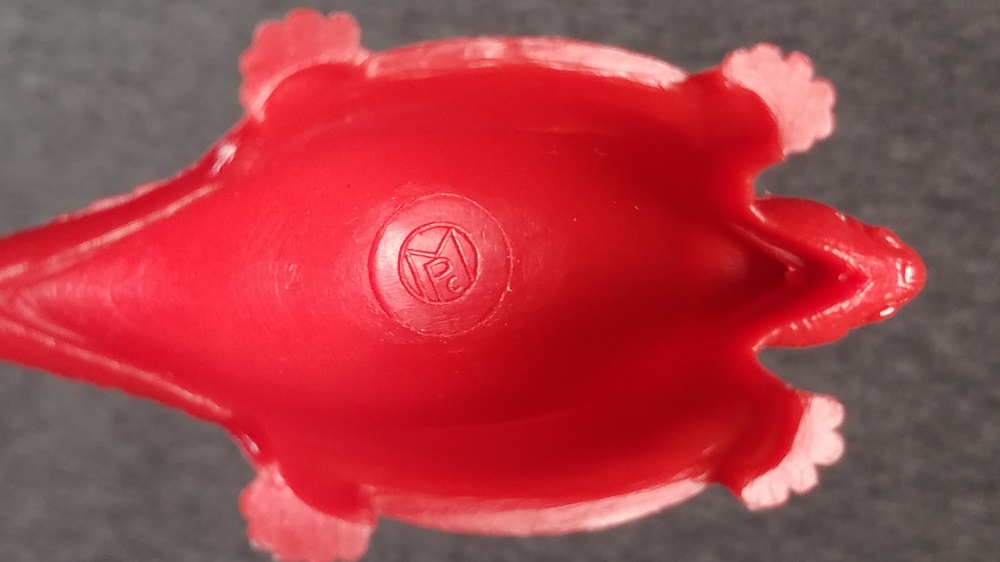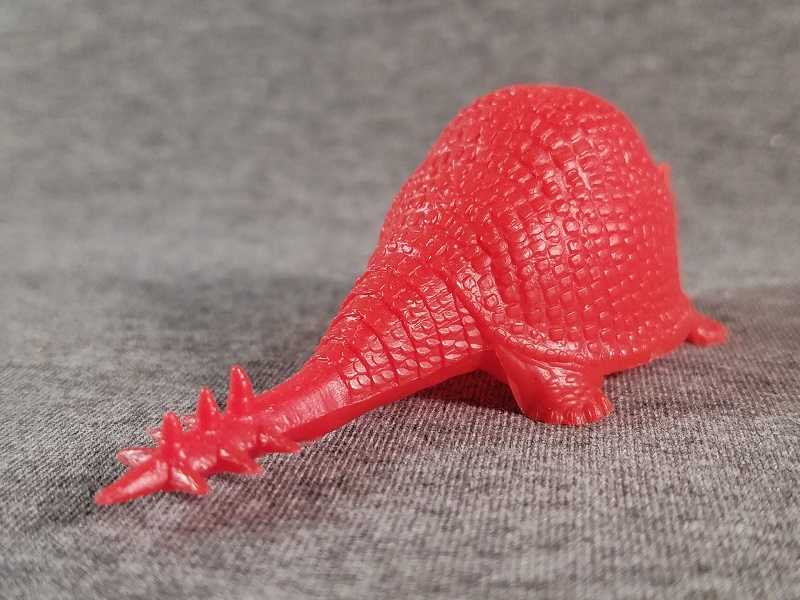One of the oldest toys of an iconic extinct mammal family still holds up pretty well, especialy alongside its more derivative contemproraries.
MPC (Multiple Products Corporations) toys are known in some circles as the “poor man’s Marx”; many of the prehistoric creatures represented in MPC’s lineup were lifted from the older Marx line, often sacrificing size and sculpt quality for bright colors and cheaper quantity. However, MPC did offer a few original sculpts amidst the copycats, and of surprisingly decent quality. Most of these new sculpts were of new genera as well, and were produced for the mold groups in MPC’s second series of sets in 1962. Of the five new genera released, three were included in a single set: the fourth overall mold group, which can be nicknamed the “Glyptodont group”.

The MPC “Glyptodont” is one of four models included in the Second Series, Fourth Mold Group, which consisted of three original mammals and a knockoff of the Marx Struthiomimus. The figure measures just under 9 cm (3.5 in) long; unlike most MPC figures, the figure is completely hollow from underneath, with the MPC logo engraved on the roof of the shell’s underside. The animal’s name and life size are engraved under the tail club, out of sight.


Although it is only identified by the general subfamily name, the MPC Glyptodont’s physical characteristics appear most closely based upon the genus Doedicurus, rather than Glyptodon itself. The figure captures a distinctively uneven, almost dented-looking slope to the backside of the body’s armor dome, which is often seen in reconstructions of the Doedicurus genus. The armor progresses down into five rows of ringed armor plates at the base of the tail. The genus’s signature tail club is less thoroughly reconstructed, having been simplified from chaotic mace of multi-sized spikes into a more tidy garden-tool arrangement, consisting of three rows of three spikes each pointing left, right, and up, with a tenth spike tipping the end of the tail. I would guess this was a design choice made for production efficiency.

Details on the armor are very good, with distinct rows of semi-round scutes(scales?) running perpendicular to the body’s length. In some regions these rows run into each other and merge – which might look like a production glitch, but actually seems to reflect legitimate reconstructions once again. The end of the tail and the club are smooth and devoid of finer details, but each foot has sculpted toes and scaly armor; and the head displays all major facial features in addition to some striated spots to replicate fur. The only eyesore is a prominent seam line through the middle of the face, which is otherwise rather cheery in expression. When you’re a near-invulnerable living tank, I suppose there’s little reason for worry in life.

MPC would cast the Gyptodont toy for many different releases over the years. To my knowledge, the Glyptodont was typically molded in red plastic. Subtle variations in the plastic are still evident to careful eyes, although a more experienced historian/collector than myself would need to explain what significance those differences may have. Amongst my own copies, some Glyptodonts have a darker hue, whereas others almost appear to be slightly translucent. The plastic quality feels the same between copies, which is fairly durable and slightly flexible for safe play (although the tail spikes are all pretty pointy still). Although many MPC models were repurposed by other companies in later years, the Glyptodont didn’t appear to be a popular choice for recasting. Most or all Glyptodonts, therefore, should be authentic original MPC casts (to my limited knowledge).

The Glyptodont family is certainly one of the most iconic groups of prehistoric mammals in popular media and literature, so my hat goes off to MPC for being a pioneer introducing the group to the toy industry. MPC started out as a weaker imitator of the superior Marx line, but the Glyptodont stands as evidence that MPC had the capability for greater things. You can often find this toy available on the second-hand market today, such as eBay or eCrater; but it is one of the more sought-after figures in the line, so I recommend buying in lots for the best prices.

Support the Dinosaur Toy Blog by making dino-purchases through these links to Ebay and Amazon. Disclaimer: links to Ebay.com and Amazon.com on the Dinosaur Toy Blog are often affiliate links, when you make purchases through these links we may make a commission

I love the few original toys produced by MPC, they compliment the Marx toys well. Great review! Looking forward to more.
Wonderful review of this model and brand. I have a purple and a yellow in my collection. It’s amazing that such simple design and model could give so much joy.
I have a yellow one of these from the 80s or 90s, probably from a Chinese company, so there were definitely recasts.
Great review. One of my favorite toys as a kid. During epic fights, I would stack them up in threes for triple the damage.
They also came in a somewhat rare green.
Nice review Fembrogon, MPC made some good figures for the 1960s when they put their minds to it and weren’t plagiarising Marx.